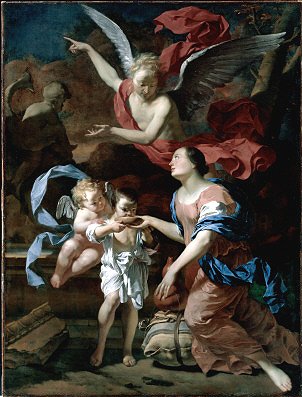 |
|
Hagar and Ishmael in the Wilderness
by Karel Dujardin, Dutch 1622-1678
SN 270 Oil on Canvas 1662
by Robert Anderson
Artist:
Karel Dujardin was a Dutch painter and draughtsman who divided his career between Italy
and Holland. He is best known for the Italianate landscapes he painted throughout his
career. These small, simply constructed scenes of herders and cattle resting in meadows or
travelling through the landscape and travellers halting at an inn are marked by refined
detail and bright colors with a sensitive interpretation of light and shade.
Dujardin also painted a number of remarkable history paintings of which
the spectacular "Hagar and Ishmael in the Wilderness" is one of his finest. It
displays Dujardin's command of large-scale, dynamic yet stable compositional forms and his
ability to render imposing figures convincingly, with sensitive features. He used cool,
modulated tonalities to create smooth surfaces and brilliant fabrics.
Later in his life, Dujardin abandoned his large figure types, replacing
them with small, agitated figures situated in large Italian riverside settings. His
brilliant, creamy technique, and light clear tonalities gave way to dark smokey colors
with rougher brushwork, harsher contrasts and fewer highlights. |
Dujardin achieved a measure of fame in his own day and was a founding
member of De Pictura, the artist's confraternity in the Hague.
Subject:
The subjects of this painting are Hagar and Ishmael, mother and son. Their story is told
in the Old Testament ( Genesis 16 and 21: 9-21). When Sarah, Abraham's wife, finally
conceived and bore her son Isaac, she demanded that Abraham send Hagar and her son Ishmael
away. Hagar had been Sarah's maid previously and had been given to Abraham in order to
assure him a son during the period when Sarah was unable to conceive. Abraham does send
them away and they wander in the desert and are close to death from the lack of water. As
Hagar prepares to die, an angel comes from God to show her the way to a spring of water.
She is also told that Ishmael will become the founder of a great nation.
Painting:
This dramatic, monumental canvas is one of Dujardin's masterpieces. He has arranged the
angel, Hagar and the tree trunks in a massive "V" that dominates the
composition. The swirling drapery and the gleaming highlights of white, red and blue are
beautifully played against this tightly balanced composition.
The language of the hands in brilliantly organized here: Hagar's left hand
touches the gourd, stopper off, presumably empty, to indicate her plight in the
wilderness, her right hand holds the cup Ishmael drinks from, the left hand of the angel
points to the fountain which has miraculously appeared to provide that water, and his
right points upward to the real source of her help. The clear progression upward, from
lower right to upper left, tells the story of her plight, her rescue, the means of her
rescue and its ultimate source.
This painting is closely related to two other paintings : St. Peter
Healing the Sick, and The Conversion of St. Paul by the same artist. Closely related in
theme, size and treatment they show heathen being converted, the sick being healed and the
outcasts being comforted. Together they represent one of the major achievements of their
kind in 17th century Dutch art.
The setting of the painting needs to be commente upon however. It appears
that Hagar and Ishmael are situated in what appears to be some Roman ruins not a sandy
area as one might expect. A wilderness or desert, however, need not mean a sandy place.
Historical Context:
The theme of Hagar and Ishmael was popular in Dutch 17th century art. Protestant Holland
was a haven for outcasts like the Jews. Ironically, its religious tolerance did not extend
equally to Catholics who constituted a sizeable minority. Though forbidden to have their
own churches, Catholics were quitely allowed to worship at home in private chapels.
Dujardin, a Catholic, must have executed Hagar and Ishmael in the Wilderness for just such
a chapel, as paintings were banned from the interiors of Dutch Calvinist churches.
|
